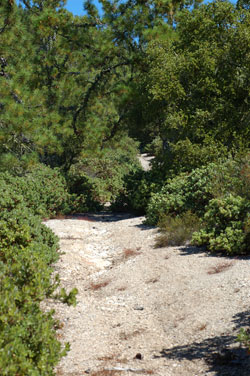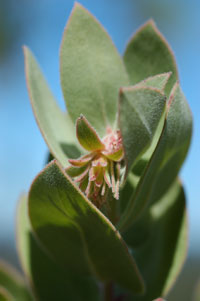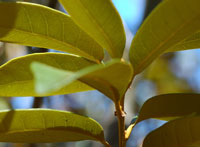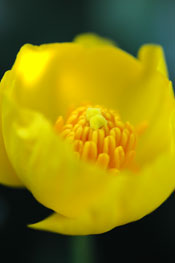A Journey Through the Scott Creek Watershed

Chalks

Near the end of our ecological tour, we enter the "Chalks," with mudstone so bleached by the elements that from a distance it looks like snow. If one were to define with a single genus this harsh and unyielding environment, then the pioneering manzanitas would win hands down. While the obligate-seeding sensitive manzanita (Arctostaphylos sensitiva) and the rare, listed  Anderson's manzanita (A. andersonii), Schreiber's manzanita (A. glutinosa), and Ohlone manzanita (A. ohloneana) reside for the most part in the upper reaches of the watershed, their genetic fingerprints manifest themselves throughout the extensive range of the burl-forming crinite manzanita (Arctostaphylos crustacea subsp. crinita). This phoenix-like, fire-regenerative taxon—a genetic sponge of such complexity that no two specimens are alike—shares habitat and longevity with the coast redwood (Sequoia sempervirens) in the chaparral, diminished in stature and often golden in hue.
Anderson's manzanita (A. andersonii), Schreiber's manzanita (A. glutinosa), and Ohlone manzanita (A. ohloneana) reside for the most part in the upper reaches of the watershed, their genetic fingerprints manifest themselves throughout the extensive range of the burl-forming crinite manzanita (Arctostaphylos crustacea subsp. crinita). This phoenix-like, fire-regenerative taxon—a genetic sponge of such complexity that no two specimens are alike—shares habitat and longevity with the coast redwood (Sequoia sempervirens) in the chaparral, diminished in stature and often golden in hue.
The paucity of soil and rapidly draining fractured substrate places severe restrictions on the growth potential of trees and shrubs, which luxuriate in the watershed's canyon bottoms and soil-retentive staggered slopes.  Canyon live oak (Quercus chrysolepis), lichen-festooned with reduced, thickened leaves contrasting with the outsized acorns, shares its aridaerie with what purports to be chaparral live-oak (Quercus wislizeni var. frutescens), displaying small, holly-like leaves, and possibly a chaparral ecotype of Shreve oak (Quercus parvula var. shrevei), with foliar margins running the gamut from entirethrough undulate-spinescent. At the opposite end of the spectrum, stature-wise, Pacific stonecrop (Sedum spathulifolium) can be found on the west-facing ridges between Bannister and Bettencourt gulches, favoring moss-lined depressions and displaying rosettes colored grass-green and tinted orange thru purple.
Canyon live oak (Quercus chrysolepis), lichen-festooned with reduced, thickened leaves contrasting with the outsized acorns, shares its aridaerie with what purports to be chaparral live-oak (Quercus wislizeni var. frutescens), displaying small, holly-like leaves, and possibly a chaparral ecotype of Shreve oak (Quercus parvula var. shrevei), with foliar margins running the gamut from entirethrough undulate-spinescent. At the opposite end of the spectrum, stature-wise, Pacific stonecrop (Sedum spathulifolium) can be found on the west-facing ridges between Bannister and Bettencourt gulches, favoring moss-lined depressions and displaying rosettes colored grass-green and tinted orange thru purple.

 As we work our way up Schoolhouse Ridge and pass through the "Chalks," we can observe en route golden chinquapin (Chrysolepis chrysophylla var. minor), chaparral pea (Pickeringia montana), bush poppy (Dendomecon rigida), yerba santa (Eriodictyon californicum), pitcher sage (Lepechinia calycina), buck brush (Ceanothus cuneatus var. cuneatus), and rush trefoil (Acmispon junceus).
As we work our way up Schoolhouse Ridge and pass through the "Chalks," we can observe en route golden chinquapin (Chrysolepis chrysophylla var. minor), chaparral pea (Pickeringia montana), bush poppy (Dendomecon rigida), yerba santa (Eriodictyon californicum), pitcher sage (Lepechinia calycina), buck brush (Ceanothus cuneatus var. cuneatus), and rush trefoil (Acmispon junceus).
At the headwaters of Mill Creek, finally, just below the drainage divide to the San Lorenzo River watershed, we reach the border of the extensive Lockheed Martin facility—an example of careful corporate land stewardship that has retained within its holdings a high degree of biodiversity. What a journey, and this is only a metaphorical overview, an interlocking chain of biological events that stretches from the bone-chilling ocean's edge to the desiccated ridges that reference the "top of the world" for the Scott Creek Watershed.
"Traversing Swanton Road," 235-page essay by James A. West documenting the 200+ native species one can see on a journey down Swanton Road (without leaving the tarmac!) is available in PDF format.
Many thanks to botanist extraordinaire James A. West for the use of his text and for showing me the beautiful sights of the Scott Creek Watershed. Website design by Dylan Neubauer. And many thanks to Mike Clark for all of his help!
 Home |
Shore |
Headlands |
Gulches |
Grasslands |
Scott Creek |
Schoolhouse Ridge |
Seymore Hill |
Chalks
Home |
Shore |
Headlands |
Gulches |
Grasslands |
Scott Creek |
Schoolhouse Ridge |
Seymore Hill |
ChalksAll photographs © Dylan Neubauer